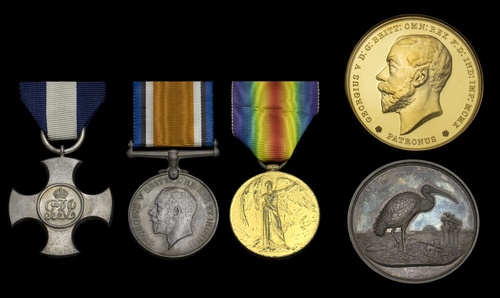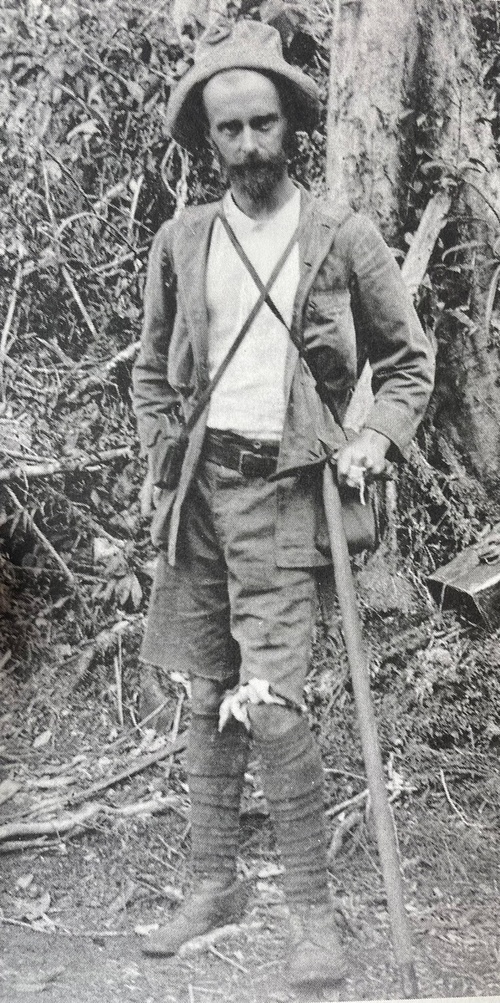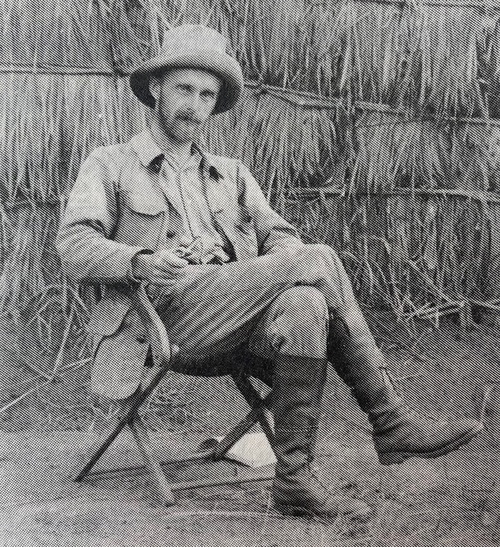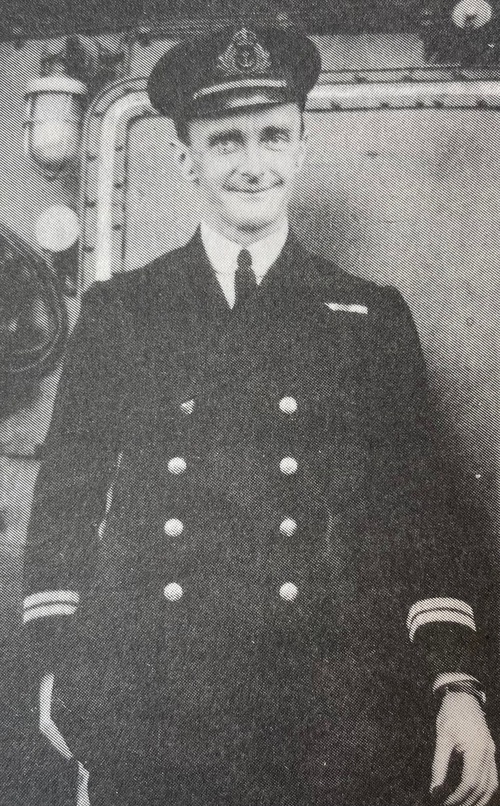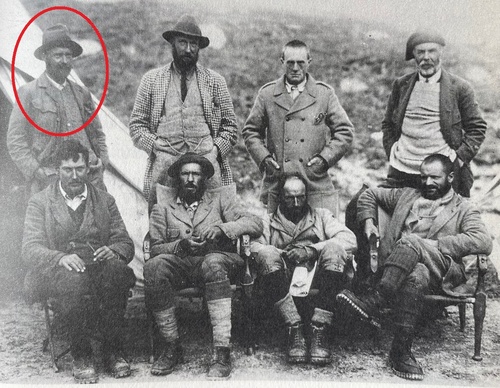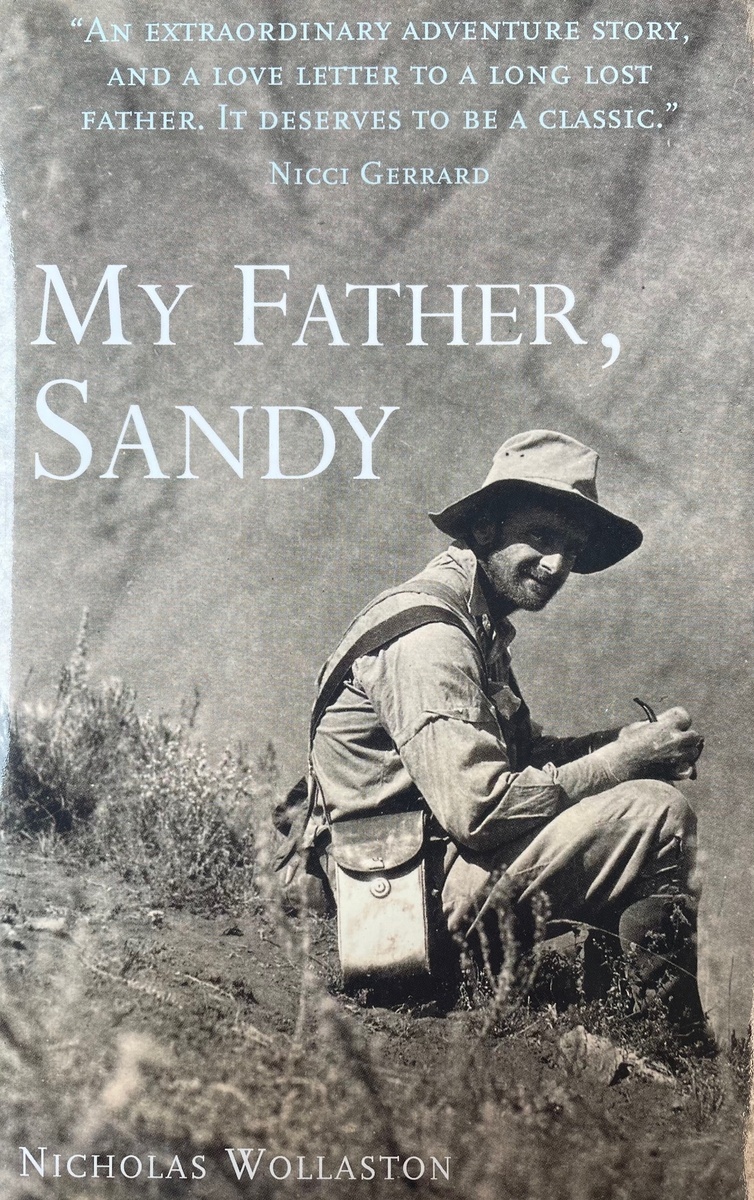Auction: 24003 - Orders, Decorations and Medals
Lot: 152
(x) 'Sandy Wollaston had led a dangerous life. He had survived expeditions to lands where people could easily disappear without trace, be eaten, end up with their heads smoked and hanging in the roof of a longhouse, where starvation, malaria, dengue fever, dysentery and drowning were constant hazards. After a dangerous life of exploration and adventure he was now effectively retired from expeditions and leading the life of a university don. Then in 1930, two weeks after taking up his new post, he was shot dead by a deranged student, D. N. Potts, who also killed a policeman, and then turned the gun on himself … '
An article by Mark O'Shea in The Herptile, refers; Vol. 38, Issue 4, December 2013.
An exceptional Great War East Africa operations D.S.C. and Gold R.G.S. Patron's Medal group of five awarded to Surgeon Lieutenant A. F. R. 'Sandy' Wollaston, Royal Navy
A noted explorer, mountaineer and naturalist, he was also awarded the Patron's Gold Medal of Royal Geographical Society in 1925, a reward for his earlier expeditions to Central Africa and Dutch New Guinea, and a rare distinction that placed him among the 'greats': one standard school text book of the period featured his achievements alongside those of David Livingstone and Robert Falcon Scott
He was indeed a daring and adventurous soul who epitomised the spirit of the Great Age of Exploration, latterly adding to his laurels by playing a key role in the British Mount Everest Expedition of 1921, when his teammates numbered Leigh-Mallory and the North-Col Ridge was identified as a viable route to the summit
On his tragic death at the hands of a demented student at King's College, Cambridge in June 1930, Stanley Baldwin - the university's chancellor - spoke of how he 'mourned a prince among men'
(i)
Distinguished Service Cross, G.V.R., hallmarks for London 1918, in its Garrard & Co. fitted case of issue
(ii)
British War and Victory Medals (Surg. Lt. A. F. R. Wollaston, R.N.)
(iii)
Gold Patron's Medal of the Royal Geographical Society (Mr. A. F. R. Wollaston), glazed, in its fitted case of issue
(iv)
Silver Medal of British Ornithologist's Union, the reverse engraved, 'A. F. F. Wollaston, B.A., New Guinea Expedition 1910-1911', in its (damaged) J. A. Restall, Birmingham fitted case, nearly extremely fine (5)
Provenance:
Spink, 14 September 1989, Lot 120.
DNW, 14 September 2012 (Lot 1004), when offered as part of 'Exceptional Naval and Polar Awards from the Collection of R. C. Witte'.
D.S.C. London Gazette 22 February 1918. The original recommendation states:
'For conspicuous devotion to duty and for his unfailing care of the sick and wounded. During the operations on the Rufiji, he not only attended to the casualties of the unit to which he was attached but he also voluntarily assisted those of the Rufiji River Transport. The Naval Officer-in-Charge of the latter men speaks highly of the assistance rendered by Surgeon Wollaston. Later, he was attached to Mafia for a period of two months during the time she was engaged in evacuating casualties from the Rufiji Delta, when he did all in his power to ensure their having proper attention.'
Alexander Frederick Richmond Wollaston was born in Clifton in May 1875, the son of George Hyde Wollaston, 'a man of wide culture and one of the most outstanding figures at Clifton College during the headmastership of John Percival', and scion of a family whose name 'occurs more often in the annals of the Royal Society than any other'; his talented mother, Sarah Constance, was a niece of the portrait painter, George Richmond.
Young Alexander also attended Clifton College, where he cared little for school life and games, but quickly gained a reputation as a first class naturalist. Going up to King's College, Cambridge in 1893, where he was one of the select few to attend the zoology lectures of Alfred Newton, he also took a long vacation, the commencement of much foreign travel, when he walked from Hammerfest through Lappland to the Baltic.
Explorer
On graduation he decided to pursue a career as an explorer, as a result of which he felt bound to qualify in medicine in order to facilitate such travel - an objective eventually achieved in London and back at Cambridge, though he found life as a medical student dull and irksome. Accordingly, he took every opportunity to escape the country, participating in climbing expeditions to the Alps and, in 1903, gaining membership of the Alpine Club.
And by way of satisfying his naturalist instincts, he twice visited the Sudan with N. C. Rothschild, collecting bird and animal specimens; so, too, by journeying as far afield as New Zealand and Japan. Then in 1906, he joined his first official expedition, namely the British Museum's expedition to the Ruwenzori mountains in Central Africa, under R. B. Woosnam. Here he climbed what was then supposed the highest peak (15,286 ft.), afterwards named Wollaston Peak by the Duke of Abruzzi, and the returned home down the Congo with Douglas Carruthers, publishing a valuable account of his travels and observations in From Ruwenzori to the Congo in 1908.
In the following year he joined the British Ornithologists' Union's expedition to Dutch New Guinea, under Walter Goodfellow, but it failed to reach the islands highest peaks on account of sickness, though Wollaston made a pioneering study of the primitive pygmy Tapiro tribe and gathered an equally valuable collection of natural history specimens. And at the request of the expedition's committee, he subsequently wrote an account of it in Pygmies and Papuans.
Nonetheless, Wollaston remained deeply disappointed by the expedition's failure to reach the peaks - the Carstensz Peaks in the Sudirman Range of the island's highlands - and thus returned to New Guinea under his own steam in 1912-13, taking C. B. Kloss as his only white companion. Their journey was very arduous, being beset by 'dense vegetation, bad climate, noxious insects and the complete absence of any local food supplies' and Wollaston's attempt to reach the highest peak at nearly 5,000 metres ended in failure, when he suffered from malnutrition and the cold. Then on making his return to his 'Depot Camp', he discovered a number of his Amungme tribe followers had mysteriously died, either from starvation or malaria. And in a final disaster, his canoe struck and obstacle and capsized, nearly drowning him.
Notwithstanding such challenges and close shaves, Wollaston and Kloss managed to secure valuable collection of ethnological and natural history specimens, and the former delivered a 'delightful lecture' at the Royal Geographical Society in early 1914. For this, and his earlier exploration, he was awarded the Society's Gill Memorial.
Sailor Surgeon - from East Africa to North Russia
The outbreak of hostilities witnessed Wollaston entering the Royal Navy as a Surgeon Lieutenant, and he quickly went to sea with the Northern Patrol in the armed merchant cruiser H.M.S. Mantua - the whereabouts of his 1914-15 Star remains unknown. Having then enjoyed further seagoing experience in the battleship Agincourt, he was embarked for East Africa in the Hyacinth in March 1916. And it was here, for the above cited deeds - while on attachment to R.M.A. units - that he earned his D.S.C.
He had in fact earlier been recommended for like recognition, in respect of the operations in East Africa in the period December 1916 to July 1917:
'Whilst the unit was encamped at Kibamawe, he volunteered to give them medical assistance, the unit to which he was attached (Heavy Artillery, R.M.A.) being at that time camped some way from there. He took a great personal interest in the men and went to considerable trouble to teach them to take proper precautions. Afterwards he was attached to the Mafia whilst she was evacuating sick from Utete and he did all in his power to make the sick comfortable and to ensure they had proper attendance.'
Wollaston returned to the U.K. in the summer of 1918, served in the Naval Intelligence Department, and was then present in further operations off Murmansk and Archangel in the monitor Humber in May-September 1919. He was again mentioned in despatches, by Captain Altham (London Gazette 12 December 1919 refers):
'I would like to bring to notice the exceptionally good work of the following officers of the Naval Medical Service with the advanced flotilla. Both these officers have to my personal knowledge performed valuable services under fire on a number of occasions.'
The Mount Everest Expedition 1921 and further exploration
Having been demobilised on his return from North Russia, Wollaston was elected to a six-years' fellowship at his alma mater, King's College, Cambridge. And his next major enterprise was the Mount Everest expedition of 1921, led by Lieutenant-Colonel C. K. Howard-Bury. His medical services to members of the expedition and to native Tibetans were highly appreciated, added to which he collected some unique plant specimens and took some of the finest photographs of the entire expedition. In July 1922, he contributed a paper to the Geographical Journal, in addition to contributing a couple of chapters to Mount Everest, The Reconnaissance.
On his return home, Wollaston married Mary, the daughter of Daniel Meinertzhagen, head of the banking house of Frederick Huth, and together they visited the unexplored Sierra Nevada of Santa Marta, in Columbia, in 1923, a paper subsequently being published in the Geographical Journal of August 1925. He was awarded the Patron's Gold Medal of the Royal Geographical Society in the same year and, in 1928, was appointed Honorary Secretary.
Murder
Re-elected a fellow at King's, he proved to be a highly successful and popular tutor, gifted as he was with a wonderful sense of humour, astonishing insight and broad outlook. He could, according to a fellow academic, 'unlock hearts with a word or a look, and break down everyone's reserves, except his own'.
Thus, his tragic death at the hands of a demented undergraduate in June 1930 caused utter horror and sadness. Stanley Baldwin, the University's Chancellor, spoke of Cambridge 'mourning a prince among men'. In his biography of his father, Nicholas Wollaston wrote:
'Sandy Wollaston lived in the last great age of discovery. He undertook extraordinarily tough expeditions to New Guinea, the Sahara and Africa, collecting flora and fauna of lasting importance. In 1930, tragedy struck. Sandy, now a Cambridge don, married with three young children, was shot dead by an undergraduate with a stolen pistol. The academic quiet of King's College was shattered. An explorer who had travelled unknown lands and climbed virgin mountains, who had lived through fevers and tribal attacks and a long war - who had been on the first expedition with Mallory to Mount Everest - died by a crazy bullet in a secluded university precinct, the chance victim of something like a South American shooting affray. To many people he became better known for his appalling death than for his distinguished life.'
His murderer - who also mortally wounded a police officer - afterwards turned his gun on himself.
Sold with several related books and pamphlets, including Wollaston's From Ruwenzori to the Congo (John Murray, 1908, ex-Lib.) and his sister's tribute volume, Letters and Diaries of A. F. R. Wollaston (Cambridge University Press, 1933, ex-Lib.), together with his son's biography, My Father, Sandy; an accompanying file of copied research also includes his poignant article in the Telegraph Sunday Magazine in October 1977 - 'Nicholas Wollaston pieces together the jigsaw of his father's murder one sunny day in the summer of 1930'.
Subject to 5% tax on Hammer Price in addition to 20% VAT on Buyer’s Premium.
Sold for
£12,000
Starting price
£7000

